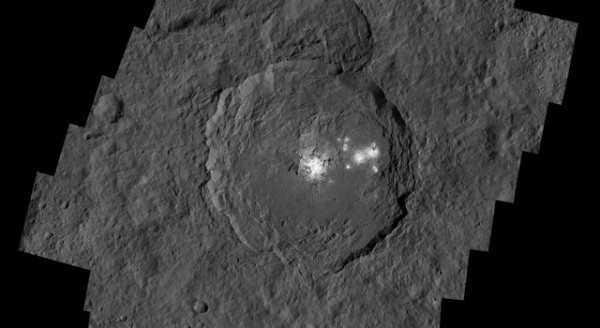By Ana Verayo, | March 24, 2016

Dawn's close-up view reveals a dome in a smooth-walled pit in the bright center of the crater.
The most detailed images of the mysterious bright spots of dwarf planet Ceres have just been released by NASA's Dawn spacecraft, zooming in on the Occator Crater of the planet.
This crater spans across 57 miles wide and runs 2.5 miles deep into Ceres' interior, which is known to house the brightest spots on the dwarf planet. These latest images were captured from 240 miles above its surface, revealing a dome shaped structure with fractures that slash across the top and its flanks, inside the crater's pit surrounded with smooth walls.
Like Us on Facebook
According to Jean-Philippe Combe from the Bear Fight Institute in Washington, the crater's current environment and conditions hints at material that used to hold water or it could be water itself that have been exposed during a surface impact or a landslide or both. This means that there could be more places on the planet where water is still present.
According to deputy principal investigator of the Dawn mission, Carol Raymond of NASA's Jet Propulsion Laboratory, these are all exciting and truly stunning images of Ceres that reveal the beautiful Occator. These new images also confirm the complex geological processes that are forming the surface of this mysterious dwarf planet.
Raymond explains that since these bright spots are now more clear, revealing surface minerals and the morphology in high resolution, the team can now determine the processes that shape Ceres. By also comparing Ceres with Vesta, more new insights can be obtained about the history of the early solar system.
Before Dawn reached Ceres last year, the spacecraft first arrived at another minor planet known as Vesta where the probe's mission was to orbit two targets, Vesta and Ceres, which are both located in the main asteroid belt between Mars and Jupiter. Dawn conducted intensive observations on Vesta for a period of 14 months in 2011 to 2012.
Last year, Dawn entered the orbit of Ceres, where mission scientists caught a glimpse of the mysterious, bright spots on its surface for the first time ever. Prior studies last year suggest that these 130 spots on Ceres change in color from concrete shades to ocean ice hues, where the spots are made from material found to be similar with hydrated magnesium sulfate or epsom salts.
-
Use of Coronavirus Pandemic Drones Raises Privacy Concerns: Drones Spread Fear, Local Officials Say

-
Coronavirus Hampers The Delivery Of Lockheed Martin F-35 Stealth Fighters For 2020

-
Instagram Speeds Up Plans to Add Account Memorialization Feature Due to COVID-19 Deaths

-
NASA: Perseverance Plans to Bring 'Mars Rock' to Earth in 2031

-
600 Dead And 3,000 In The Hospital as Iranians Believed Drinking High-Concentrations of Alcohol Can Cure The Coronavirus

-
600 Dead And 3,000 In The Hospital as Iranians Believed Drinking High-Concentrations of Alcohol Can Cure The Coronavirus

-
COVID-19: Doctors, Nurses Use Virtual Reality to Learn New Skills in Treating Coronavirus Patients







